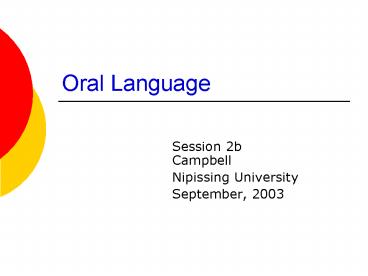Oral Language PowerPoint PPT Presentation
1 / 27
Title: Oral Language
1
Oral Language
- Session 2b Campbell
- Nipissing University
- September, 2003
2
Session 2b Outline
- What is Language?
- Acquisition of Language
- Stages of Language Development
- Hallidays Functions of Language
- Toughs Categories of Language
- Strategies and Assessment
- Informative Websites and Resources
3
- Development of language follows an orderly and
predictable course dictated by the nature of
language and by a set of basic learning
strategies that form part of human nature
4
What is language?
- As a large group, brainstorm key
features/characteristics formulate a working
definition.
5
How do children acquire language?
- children listen and observe those around them use
language in meaningful ways - children imitate, invent and try out language on
their own - tasks involved in the acquisition of language
- acquisition of vocabulary
- metalinguistic awareness (phonological,
syntactic, semantic) - overcoming egocentrism (interactive)
- learning to use language in different settings
(pragmatics)
6
Principles of language learning
- children learn language by invention not simply
through observation and imitation - young children have the ability to abstract
regularities out of an environment where examples
are not presented in any orderly sequence, rules
are not explained or directly stated and little
or no attempt is made to emphasize patterns
7
Stages of language development
- NAMES FOR THINGS holophrastic speech words that
are sentences - COMBINING OF WORDS appearance of word strings
signals the beginning use of grammar and syntax - EARLY SENTENCE FORMATION telegraphic speech
some words and word endings are omitted words
most critical to meaning are included
8
Oral language development
- What is talk?
- In small groups brainstorm what talk is and why
we engage in talk.
9
Oral Language
- Why do we talk?
- to explore
- to co-operate
- to communicate
- What to observe
- Speaking, listening, modifying ideas
- Taking turns, building on ideas
- Presenting, responding, understanding
10
Hallidays Model of Language Functions
- suggests that language learning is not a unified
achievement that children dont just learn
language they learn languages seven different
variations of the same one - each language serves a distinct function which
children can combine and blend for different
purposes
11
Oral Language Functions
- The instrumental model
- Gimme!
- The regulatory model
- Stop that!
- The heuristic model
- Whats that?
12
Oral Language Functions
- The interactional model
- How are you feeling?
- The personal model
- Im scared
13
Oral Language Functions
- The imaginative model
- Knock, knock, whos there?
- The representative model
- Its snowing!
14
Toughs Seven Categories of Talk
- uses of language should be seen as representing a
developmental sequence - childs earliest efforts to use language seem to
be self-maintaining, directing, and reporting - predicting, projecting, imagining and reasoning
make a later appearance - strategies selected indicate the complexity of
thinking - as children gain more control over a particular
strategy, they first use it by referring to
present experience, then past experience or
future experience, and lastly in imaginative
contexts
15
(No Transcript)
16
Oral Language Assessment
- Tools
- Checklists
- Profiles
- Formal Tests (e.g., TOLD)
- Tape recordings
- Observations
17
Oral Language Assessment
- Contexts
- Interviews
- Individual conferences
- Small groups lessons/discussions
- Large group instructional time
- Classroom activities, recess, etc,
- Listening activities (read-alouds, etc.)
18
Oral Language Teaching Strategies
- To promote talking and speaking skills
- Read alouds
- Retelling stories
- Storytelling Drama Puppets
- Peer talk
- Listening centres (books and tapes)
19
Oral Language Teaching Strategies
- To promote talking and speaking skills
- Literature Circles
- Readers Theatre
- Debates
- Oral presentations
- Excellent models
20
Oral Language Teaching Strategies
- To promote talking and speaking skills
- Vocabulary building activities
- Word Walls
- Trading cards
- Word games
- Word of the day
- Verbal-visual word association
21
Oral Language Teaching Strategies
- Promoting a wide range of functions
- 1. Instrumental rules of etiquette, book
persuasions - 2. Regulatory have students explain a sport or
hobby give instructions - 3. Interactional role playing have students
host Parent Lunch
22
Oral Language Teaching Strategies
- Promoting wide range of functions
- 4. Personal use well-chosen literature to open
up feelings tell personal stories - 5. Heuristic model good questioning teach this
directly - 6. Imaginative fantasy stories, playing with
language
23
Oral Language Teaching Strategies
- Promoting wide range of functions
- 7. Representational report on actual events in
the school/community develop show and tell to
emphasize clear reporting (use the 5 Ws) and
excellent questioning (model this, and praise
progress)
24
Oral LanguageTeaching Strategies
- To promote listening skills
- Teacher modeling
- Setting clear expectations
- Directed Listening-Thinking Activities (Listen
for) - Listening Games
- Daily read alouds
25
Summary
- Assess oral language development in a variety of
ways - Promote talking and listening skills using
multiple strategies, in a variety of contexts,
for a wide range of purposes or functions - Model excellent speaking and listening at all
times
26
Informative Websites
- http//server2042.virtualave.net/momagen/language.
html - http//www.childcareaware.org/en/dailyparent/vol10
/
27
References
- Assessing Language Arts, Min. of Ed., 1991
- Language Literacy A Lively Approach, Temple
Gillet, 1996 - Literacy for the 21st Century, Tompkins, 2003
- Resources to Support the Reading Classroom, Peel
DSB, 2003

